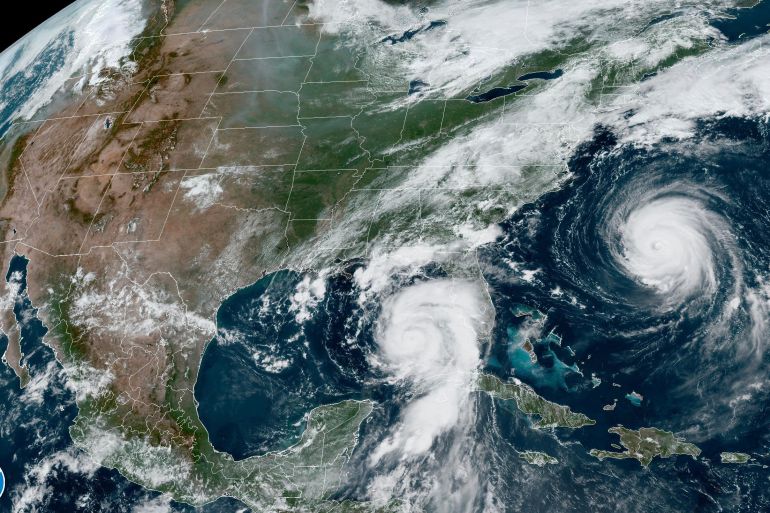Hurricane Idalia strengthens to category 4 storm as it nears Florida
The storm, described as ‘an unprecedented event’, is projected to come ashore in Florida’s Big Bend region early on Wednesday.

Hurricane Idalia has strengthened to a dangerous category 4 storm as it steams towards Florida’s Big Bend region and threatens to unleash life-threatening storm surges and rainfall.
Idalia was projected to come ashore in the United States early on Wednesday as a category 4 storm with sustained winds of at least 210 kilometres per hour (130 miles per hour) in the lightly populated Big Bend region, where the Florida Panhandle curves into the Florida peninsula. The result could be a big blow to a state still dealing with lingering damage from last year’s Hurricane Ian.
Keep reading
list of 3 itemsPhotos: Hurricane Idalia strengthens as it churns towards Florida
‘A hot tub’: Florida sees record water temperatures, raising alarm
The National Weather Service in Tallahassee called Idalia “an unprecedented event” since no major hurricanes on record have ever passed through the bay abutting the Big Bend.
Hurricanes are measured on a five-category scale with category 5 being the strongest. A category 3 storm is the first on the scale considered a major hurricane. The National Hurricane Center said a category 4 storm causes “catastrophic damage”.
At 5am (09:00 GMT) on Wednesday, Idalia was 97km (60 miles) west of Cedar Key and 145km (90 miles) south of Tallahassee, the National Hurricane Center said. It was moving north at 24km/h (18mph).
5am EDT 30 Aug: #Idalia has become an extremely dangerous Category 4 hurricane, and is nearing landfall in Florida Big Bend region this morning. Catastrophic & life-threatening impacts from Storm Surge & Winds expected as Idalia moves ashore. https://t.co/y75tVkKVK7 pic.twitter.com/0NfINii9Mo
— National Hurricane Center (@NHC_Atlantic) August 30, 2023
‘You really gotta go now’
Florida residents living in vulnerable coastal areas were ordered to pack up and leave as Idalia gained strength in the warm waters of the Gulf of Mexico and authorities warned of a “catastrophic storm surge and destructive winds” when the storm moves ashore on Wednesday morning.
On the island of Cedar Key, Commissioner Sue Colson joined other city officials in packing up documents and electronics at City Hall on Tuesday.
She had a message for the almost 900 residents, who were under mandatory orders to evacuate. “One word: Leave,” Colson said. “It’s not something to discuss.”
More than a dozen state troopers went door to door warning residents that the storm surge could rise as high as 4.5 metres (15 feet).
Governor Ron DeSantis repeated the warning on Tuesday afternoon.
“You really gotta go now. Now is the time,” he said at a news conference.
Earlier, the governor had stressed that residents didn’t necessarily need to leave the state but should “get to higher ground in a safe structure”.

Southern states gear up
After making landfall in the Big Bend region, Idalia is forecast to cross the Florida peninsula and then drench southern Georgia and the Carolinas on Thursday.
Both Georgia Governor Brian Kemp and South Carolina Governor Henry McMaster announced states of emergency, freeing up state resources and personnel, including hundreds of national guard soldiers.
“We’ll be prepared to the best of our abilities,” said Russell Guess, who was topping off the gas tank of his truck in Valdosta, Georgia. His co-workers at Cunningham Tree Service were doing the same. “There will be trees on people’s houses, trees across power lines.”
Asked about the hurricane on Tuesday, President Joe Biden said he had spoken to DeSantis and “provided him with everything that he possibly needs”.
The National Oceanic and Atmospheric Administration recently said the 2023 hurricane season would be far busier than initially forecast, partly because of extremely warm ocean temperatures.
The season runs through November 30 with August and September typically the peak.